
Just Grace Virtual Book Table
The Just Grace Committee of All Saints Lutheran Church in Bowie, Maryland, presents this virtual book table to share some of our favorite reads with you!
The books listed below are personal selections made by committee members who have provided a short note about the book and why it was meaningful to them. You will see nonfiction, memoirs, fiction, and children’s books that can be found in your local public library. We invite you to browse the book list; click on a title to read about these noteworthy books.
Nonfiction
How the Word is Passed: A Reckoning with the History of Slavery Across America
By Clint Smith
Four Hundred Souls: A Community History of African America, 1619–2019
Edited by Ibram X. Kendi and Keisha N. Blain
On the Courthouse Lawn: Confronting the Legacy of Lynching in the Twenty-first Century
By Sherrilyn A. Ifill
My Grandmother’s Hands: Racialized Trauma and the Pathway to Mending Our Hearts and Bodies
By Resmaa Menakem
Good White Racist? Confronting Your Role in Racial Injustice
By Kerry Connelly
On Juneteenth
By Annette Gordon-Reed
Memoir
Real American: A Memoir
By Julie Lythcott-Haims
The Color of Water: A Black Man’s Tribute to His White Mother
By James McBride
Fiction
Jazz
By Toni Morrison
Song Yet Sung
By James McBride
Children’s
Shades of Black: A Celebration of our Children
By Sandra L. Pinkney
Please, Baby, Please
By Spike Lee and Tonya Lewis Lee
The Story Behind Juneteenth
By Jack Reader

![]() How the Word is Passed: A Reckoning with the History of Slavery Across America
How the Word is Passed: A Reckoning with the History of Slavery Across America
By Clint Smith
Annotation from Liz Muller
In his prologue to How the Word is Passed, Clint Smith observes that our country is at an “inflection point”; while there is an increased willingness to grapple with the legacy of slavery, recognizing the myriad ways it shapes both our personal perspective and our world view, there is, simultaneously, a more systemic, concerted effort to disavow or misrepresent our nation’s history. This book is Smith’s attempt to better understand how both individuals and institutions in this country perceive their relationship with our history of enslavement. He shares his discoveries as he visits seven sites that represent that history, whether by exposing the hard truths of our past or by running from it.
Though I considered myself familiar with the essential facts of that history, the book’s revelations humbled me at every turn. There are still so many gaps in my knowledge and truths to which I had been oblivious, e.g. the many locations in NYC that visibly testify to the city’s essential role in perpetuating slavery.
Clint Smith, like me, was an English teacher (in fact, he taught in Prince George’s County schools) who observed that his students’ sense of our nation’s history as well as their experience of their own family history shaped their view of themselves, their education, and their world. His love of those students was a primary impetus for writing this book. I think our love of our children, our nation’s future, and our reverence for truth necessitate our reading and reflecting on our collective past and how that history is or isn’t passed down.
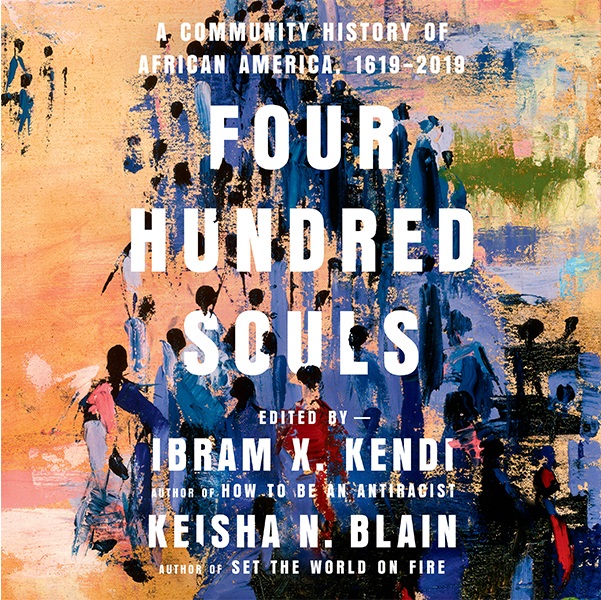
![]() Four Hundred Souls: A Community History of African America, 1619–2019
Four Hundred Souls: A Community History of African America, 1619–2019
Edited by Ibram X. Kendi and Keisha N. Blain
Annotation from Pat McCartney
Since I am not a history buff, I truly admire historians and journalists who can transform dry documents into engaging stories. These skillful editors curate contributions from a diverse community of Black writers into very short chapters, of three to five pages, that span 400 years of African American history from 1619 to 2019, in ten time frames. I chose this book because I recognized so many of these contributors, including names you will recognize too. Chapters are written by William Barber, Donna Brazile, Alicia Garza, Anne Gordon-Reed, Nicole Hannah-Jones, Sherrilyn Ifill, Heather McGhee, Tiya Miles, Imani Perry, Clint Smith, Jamar Tisby, and Isabel Wilkerson, just to name a few.
The editors aim for this compilation to not only write history but to be history by marking the four hundredth year of African America. In doing this, they often write for people who did not have the opportunity to tell their own stories. Indeed, I read many engaging historical accounts from perspectives that were new to me. For each time frame, I compared what I was reading with what I was taught in my own schooling. I reflected on many of the stories and author commentaries. What makes a good ally? What can we learn from the freedom church? And, as I examined each writer’s bio at the back of the book, I found more of their books that I wanted to read!
Try this book, it is designed to be read at your own comfortable pace. The short chapters make it suitable to be read in separate sittings.

![]() On the Courthouse Lawn: Confronting the Legacy of Lynching in the Twenty-First Century
On the Courthouse Lawn: Confronting the Legacy of Lynching in the Twenty-First Century
By Sherrilyn A. Ifill
Annotation from Diane Hampton
Nearly 5,000 Black Americans were lynched in the United States between 1890 and 1960. On the Courthouse Lawn examines the numerous ways that racial trauma still exists throughout the country today. While the lynchings and their aftermath were devastating to the families and communities at the time, the long-term impact is still felt today through the marginalization of political and economic development for Black Americans. This book investigates how average white citizens actively participated in the lynchings but were never held accountable for their horrific actions. Many others stood by and witnessed the appalling lynchings and did nothing to stop them. Ifill traces the lingering impact of two lynchings in Maryland to illustrate how the history of racial violence impacts the legacies of those communities today.
Ifill also provides concrete ideas to help communities heal, including placing gravestones to mark the burial sites of lynching victims, creating commemorative public spaces, establishing school curricula on the history of lynchings, issuing public apologies, and financially compensating the descendants of lynching victims and those whose family homes or businesses were destroyed in the aftermath of the lynchings. Ifill emphasizes that the contemporary effects of racial violence are experienced most intensely in local communities, and therefore, reconciliation and reparation efforts must also be locally based to bring Black and white Americans together in a dialogue of healing.
I read On the Courthouse Lawn for a book discussion group as part of the Prince George’s County Lynching Memorial Project. I did not grow up in Maryland (moved here after college) and was not aware of the history of lynchings in Maryland. I found the book extremely enlightening about a part of history that wasn’t taught in schools. I encourage others to read the book to increase their understanding of how history impacts the current social and political climate.

![]() My Grandmother’s Hands: Racialized Trauma and the Pathway to Mending Our Hearts and Bodies
My Grandmother’s Hands: Racialized Trauma and the Pathway to Mending Our Hearts and Bodies
By Resmaa Menakem
Annotation from Emily DeMarco
I decided to read My Grandmother’s Hands at the invitation of Bishop Leila Ortiz, who recommended the book for Black History Month. I commend it to all adult readers, especially those who are uncomfortable talking “about race.”
The central premise of this book is, in the author’s own words, “What you call ‘the racial divide’ is not an obstacle to be conquered; it’s a wound that lives inside our bodies—a wound we can heal.” Resmaa Menakem explains how trauma influences our bodies’ reactions—which we can feel though tangible sensations like tightness in the belly—which then influence our emotions. By soothing ourselves using techniques he shares, we can bring the thinking, empathetic brain to the forefront, enabling us to respond in ways that are more constructive and serve to actually heal the underlying trauma.
I found in this book a lot of grace, which can be missing in public conversations about race. Menakem explains how white-body supremacy harms everyone, including white people and law enforcement officers. I was able to experience greater empathy as a result. I found the exercises in each chapter a good mix of accessible and challenging, and have already used some of the practical suggestions for things we can each do in daily life.
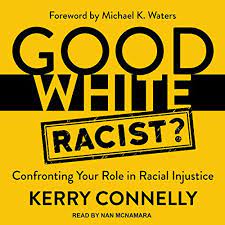 Good White Racist? Confronting Your Role in Racial Injustice
Good White Racist? Confronting Your Role in Racial Injustice![]()
By Kerry Connelly
Annotation from Liz Muller
Good White Racist? is not my breezy summer beach read recommendation. In truth, it was one of the most humbling, “in my face” books I have read in awhile. Yet, like most encounters that provoke discomfort, the experience of reading this book offers a necessary opening to growth and change for all of us who consider ourselves well-intentioned white Christians. Connelly defines “good white racists” as persons like herself, and like me: “nice” people who intellectually do not approve of racist behaviors but who, often unknowingly, practice them, who benefit from and perpetuate embedded racist systems. When confronted with this portrait of ourselves, our impetus is to respond defensively because, in truth, our primary concern is our own comfort and the assurance of our inherent goodness. Her book offers many persuasive, often personal illustrations of our complicity in perpetuating racism. She accompanies those examples with “learn, think, and act” responses, tracing a pathway for us to move from being self-identified nonracists to being repentant, antiracist activists who move beyond our intentions, beyond our focus on charity to an emphasis on justice. A beach read recommendation–no–but a book which serves as a testimony to our necessary awakening and response lest our own ship of state is beached, lest our self-proclaimed belief in equality, our trust in our inherent goodness runs aground!
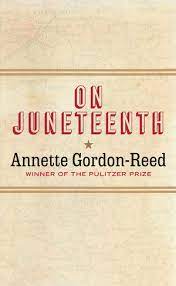 On Juneteenth
On Juneteenth![]()
By Annette Gordon-Reed
Annotation from Pat McCartney
On Juneteenth is a thin book of essays written during the pandemic by the Pulitzer Prize winning author, Harvard history professor, and proud Texan, Annette Gordon-Reed. I was eager to read this new book because I was drawn to her credentials as an academic author. This is a history book, with facts and dates referenced, but also a thoughtful personal memoir of growing up celebrating Juneteenth as “a holiday expressly for Black Texans.” The book is full of interesting Juneteenth history, and while I recommend it for an historical background, what moved me most was how forthright this accomplished historian was about the continual need to interrogate history. She humbly acknowledges how much she herself learned about the complex history of her own home state in the background research for this book. She considers the historical narratives of Texas and questions how much of these narratives were created out of a desire to feel good about Texas and adds “History is always being revised, as new information comes to light and when different people see known documents and have their own responses to them, shaped by their individual experiences.” For me, this book reinforced the need for continued learning and conversation about the Black experience in America. Gordon-Reed concludes that although we love our communities, we must be willing to engage in critical reflection in our journey to acknowledge truths. I can’t help but generalize her conclusion to critical reflections in the journeys of our own neighborhoods and faith communities to acknowledge truths.
 Real American: A Memoir
Real American: A Memoir![]()
By Julie Lythcott-Haims
Annotation from Liz Muller
I was enticed to read Julie Lythcott-Haims’ Real American after catching the last 30 minutes of her April 19 “Fresh Air” interview on NPR. I recommend both the interview and the book to you; they are candid portrayals of Lythcott-Haims’ struggle to overcome her internalized oppression and her sense of being “other” as a light-skinned Black American. Born to a successful Black physican father and a well-educated, white mother who lived for years in Africa before moving to the US, Lythcott-Haims was raised to identify as Black though her parents raised her in a white Midwest environment. Bright, well-liked, and accomplished, Julie nevertheless internalized the racist messages and micro-aggressions she experienced throughout her childhood and young adulthood, the result being a self-loathing that plagued her for 40 years in spite of her many academic and professional achievements at Harvard Law School and Stanford University. Her journey toward learning to love herself as a light-skinned Black person who could be welcomed and embraced within the Black community is instructive for all Americans as we confront the depth of racism’s often unseen grip on our psyches and our American experience. Lythcott-Haims’ portrait of her mother was also instructive for me. Despite her vast knowledge and appreciation of Black culture and her fierce love for her daughter, she needed to acknowledge her white blindness to her daughter’s experience as a marginalized Black woman. At 82 that white mother and educator continues to learn, listen, and advocate for all children of color.
 The Color of Water: A Black Man’s Tribute to His White Mother
The Color of Water: A Black Man’s Tribute to His White Mother![]()
By James McBride
Annotation from Ruth Ann Killion
The subtitle of this book is what initially drew me to read it. As the adoptive mother of two multiracial sons, I am always interested in learning more about what kinds of experiences others like them have. It is the story of James, his eleven siblings and his mother, Ruth (Ruchel, Rachel) McBride Jordan, who was Jewish, and the two black men she married. James is the eighth of twelve children and was born after his birth father, Andrew McBride, had died of cancer. The younger children were fathered by Hunter Jordan, Ruth’s second husband.
The book is an exploration of the life of Ruth. She was very reluctant to share her life story with her children and it took James ten years to tease it out of her. She grew up the daughter of a racist Jewish Rabbi who sexually abused her and treated her disabled mother very poorly. The book proceeds in an iterative fashion with one chapter about Ruth’s life then a chapter about James and his siblings growing up. James writes with mirth and candor about everything.
“The Color of Water” appears only once in the book (p. 51 in Kindle) yet is so profound that it influences everything about how Ruth lived her incredible faith life after she converted to Christianity. You’ll have to read it to find out what is the color of water! So insightful!
In an example of the type of writing you will find in this book, in an afterword written ten years after publishing the book, James talks about the three Baptist and one Lutheran church his mother regularly attends. “She goes to the white Lutheran church when she wants to get out on time.” Ruth McBride Jordan died in 2010 after living a very full life that included her shepherding all of her children through college and many to be doctors, nurses or lawyers. James is an author of renown and a jazz musician.
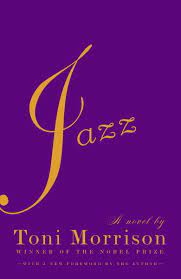 Jazz
Jazz![]()
By Toni Morrison
Annotation from Austin DeMarco
Jazz by Toni Morrison is a musical novel, both in name and content. Throughout the book, Morrison writes with a lyrical style, playing with the sound of words, phrases, and sentences to intimately convey the novel’s story. Jazz as a musical genre originated in the African American community in Harlem. In a jazz composition, the musician has the freedom to experiment with the fundamental chords of the piece, turning its motifs around again and again to create something wholly individual. Morrison does the same thing with language, interjoined with her narrative, exploring how her characters dance around each other, their desires, and the circumstances of their lives. As a genre, jazz is quintessentially human. It is messy and hopeful at the same time, just like we are. But it is also born directly from the African American experience, from pain and trauma and the hope that comes from turning over one phrase to perchance find something better on the other side. Jazz conveys this hope in more than just its story. The very language of this book is wrought from African American heritage and clearly shows how the echoes of that heritage persist today.
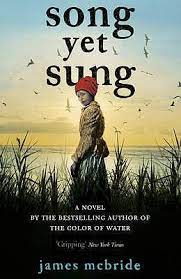 Song Yet Sung
Song Yet Sung![]()
By James McBride
Annotation from Pat McCartney
I am a fan of James McBride. His books are page-turners. Song Yet Sung is a fictional account of the lives of enslaved people right here in the wetlands and plantations of the Maryland Eastern Shore. The suspenseful plot involves a woman who is a runaway slave and the slave-hunter seeking to find her, as she negotiates the secrets of the underground railroad. Although the characters are fictional, the book has an historical foundation. I read this book before the pandemic and just before I visited the Harriet Tubman historic sites with a friend. As I toured with my friend, McBride’s characters came alive, and I reflected on how he personalized the experience of both the enslaved people and the people who enslaved them. The book provided a new lens for me and helped me in my own work toward acknowledging truth. I recommend this book to local Marylanders who know these Eastern Shore locations. Read this book before you visit the historical sites!
 Shades of Black: A Celebration of our Children
Shades of Black: A Celebration of our Children![]()
By Sandra L. Pinkney
Annotation from Diane Hampton
This book is a joyous celebration of children and an invitation to readers of all ages and cultures to explore and embrace the rich diversity among African Americans. Photographic portraits and striking descriptions of varied skin tones, hair textures, and eye colors convey a strong sense of pride in a unique heritage. Through the poetic language of Sandra L. Pinkney and the stunning photographs by Miles C. Pinkney, African American children of all shades will identify and affirm their unique characteristics. My grandchildren loved finding themselves among the portraits.
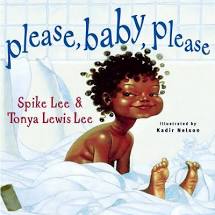 Please, Baby, Please
Please, Baby, Please![]()
By Spike Lee and Tonya Lewis Lee
Annotation from Diane Hampton
Please, Baby, Please is intended to be read to toddlers about the adventures and misadventures of very young children. Beautifully illustrated by Kadir Nelson, the book includes amusing stories of playtime, bath time, meal time and bedtime. It also addresses sibling relationships and the trials all parents face with active, independent, and often stubborn little ones. Parents of young children will be entertained by the anecdotes, and perhaps will learn some new strategies for parenting. I enjoyed reading this book to my grandchildren.
 The Story Behind Juneteenth
The Story Behind Juneteenth![]()
By Jack Reader
Annotation from Pat McCartney
I ordered this children’s book, The Story Behind Juneteenth, primarily because the cover was an engaging color photograph of a contemporary Juneteenth celebration! I did find the illustrations to be well done; so important for children. The illustrations include historical drawings and photographs telling the history of slavery, the Civil War, the Emancipation Proclamation, and Juneteenth. Texas is recognized as the first state to make Juneteenth an official holiday. This 22-page book is part of a children’s history series categorized at a Grade 1-2 reading level with a table of contents, glossary, and index. I would recommend this book for introducing children to Juneteenth and to an historical book format. Reading this book as an adult furthered my ability to talk with children about Black history in America.
